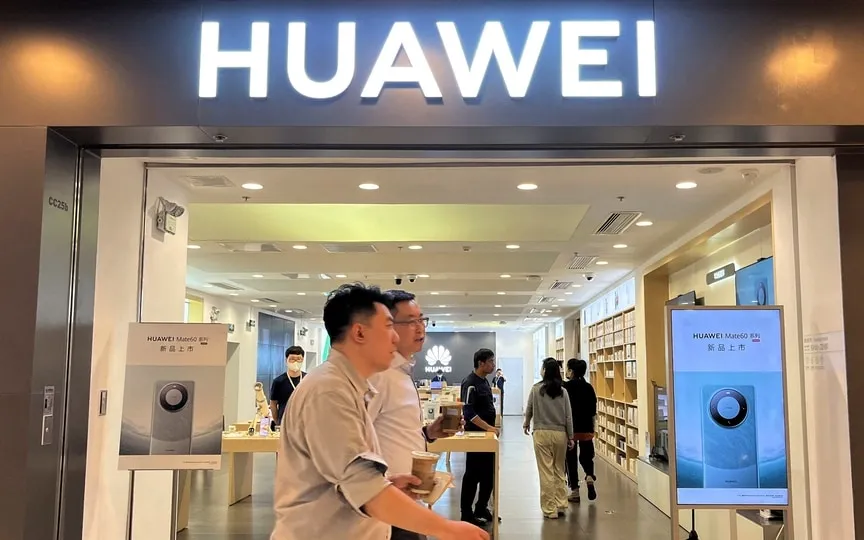Huawei Chip Proves US Restrictions Are Leaky, Not Ineffective
The release of Huawei Technologies Co.’s latest smartphone, the Mate 60 Pro, has sparked a renewed discussion on chip technology and China’s ability to bypass restrictions imposed by the US. This event highlights the ambiguous nature of the effectiveness of sanctions, as the true consequences are still uncertain.
Efficient and fast connection speeds indicate that the new streamlined device is equipped with 5G wireless capabilities and an advanced system chip manufactured by Shanghai Semiconductor Manufacturing International Corp. 350 megabits per second. It is similar to fifth-generation mobile phone standards and corresponds to Apple Inc.’s iPhone phones.
The news sparked optimism in China that domestic technology is catching up with foreign competitors, even as sales of semiconductors and manufacturing equipment to the country were tightened. “There is hope that Chinese companies will be able to cope with US government sanctions and restrictions on chip supplies,” the government-backed China Daily wrote.
Regulations announced by the US Department of Commerce last October restrict the export of manufacturing tools that can push processors to 16 nanometers or smaller (smaller geometries are more advanced). Allies, including major equipment exporters Japan and the Netherlands, agreed to abide by these rules.
Neither Huawei nor SMIC has released the specifications of the chip inside the Mate 60 Pro. Still, the processor’s size and performance mean it’s almost certainly made by SMIC at 7nm or better, Dylan Patel, founder of semiconductor researcher SemiAnalysis, told me this week.
Tests by Canadian researcher TechInsights in July of last year on an earlier chip, the MinerVA7 Bitcoin Miner, a simpler processor used for mining cryptocurrency, showed that the SMIC had reached 7nm. The latest chip is the Kirin 9000s, developed by Huawei subsidiary HiSilicon TechInsights, according to a teardown this week. According to HiSilicon, this chip is made on a superior 5nm node, although Bloomberg News reports that it is made on SMIC’s most advanced 7nm process.(1)
This makes the latest development evolutionary rather than revolutionary, so the celebrations in Beijing and the hand-wringing in Washington are both premature.
“It’s a breakthrough, but not unexpected. SMIC already showed it could make simpler chips at 7nm, and this is a step up from previous work, Patel said. Such progress is possible because older tools designed to make smaller chips can still make more sophisticated semiconductors, Patel said.
Various innovative techniques can be implemented to shrink connections beyond what could be theoretically possible. The most common approach, called multi-patterning, was first developed 40 years ago, and even world leader Taiwan Semiconductor Manufacturing Co. use it. Instead of exposing the silicon wafer to light just once to mark the circuit design, this step is done many times. SMIC, like TSMC before it, can reach 7nm by performing this lithography step four times or more, Patel said.
There is a downside. This increases the number of tools required – four sets instead of one – which increases costs and slows production capacity. However, such additional costs are marginal and can be reduced by effectively managing the production process.
The larger consequence is that the restrictions defined by the Ministry of Commerce’s Industry and Security Agency do not meet their purported goal. In practice, the US administration has written rules to restrain the means (the means), but they were defined by the ends (the end product).
This is like banning jet engines capable of 100 knots without acknowledging that an aircraft manufacturer could simply add four engines instead of one to increase thrust and higher speeds. Sure, four engines can be overwhelming, inefficient and expensive, but when the ends justify the means, a sanctioned actor is innovative.
Another gap in this regulatory fence is that devices are still being shipped. Dutch export restrictions affecting key equipment supplier ASML Holding NV came into force on 1 September. The Veldhoven-based company has permission to send three more advanced tools using deep ultraviolet technology to China by the end of the year. It does not expect to be authorized to supply more of those devices starting next year, it said.
Decision makers need to be patient before they decide whether device curbs actually work. It is possible that the current restrictions will still allow Chinese companies to enter 5nm, although they will still lag behind leaders TSMC, Samsung Electronics Co and Intel Corp. for several years. By comparison, TSMC started shipping at 7nm five years ago, and this year it’s producing chips with N3E, which is much more advanced than what SMIC seems to have achieved with its Huawei chip.
It’s highly unlikely that Chinese chipmakers can squeeze more out of legacy tools to get them beyond 5nm, meaning they’ll be stuck as foreign competitors continue to advance. And if they make further breakthroughs, the US and its allies have many ways to tighten their restrictions, including expanding the scope of the device ban and adding materials to the list.
So far, however, Beijing has found a way around foreign chip restrictions. The celebration is well-deserved, but it may not last.
More on Bloomberg’s opinion:
- China painted itself as a semiconductor corner: Tim Culpan
- Xi must work for the economy to avoid Mao’s fate: Minxin Pei
- China’s recession could save the world: David Fickling
(1) TSMC was originally expected to manufacture Kirin at 5nm, but the US curb may have forced TSMC to reject the order, resulting in SMIC making the chip at 7nm.




